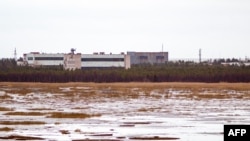Officials at the Vienna-based Comprehensive Nuclear-Test-Ban Treaty Organization (CTBTO) say that two nuclear monitoring stations in Russia have resumed operations after mysteriously halting the transmission of data.
The CTBTO did not comment on August 20 on the other two stations which it previously said had gone silent in the aftermath of an explosion at a Russian naval test site that killed at least five people and caused a temporary spike in radiation levels.
Russia operates a total of six monitoring stations that scan for so-called radionuclide particles wafting through the air.
Silence at several of the stations raised fears that Moscow was hiding the extent of the blast.
"RN stations RUP 56 (Peleduy) and RUP 57 (Bilibino) have resumed operations in Russia & are currently backfilling data," Lassina Zerbo, executive secretary of the CTBTO, said in a message on Twitter.
"Excellent cooperation & support from our Russian station operators under 'The Provisional Operation Status of the IMS,'" he added, referring to the International Monitoring System that collects and monitors data worldwide on radiation in the atmosphere.
Kremlin spokesman Dmitry Peskov told reporters on August 20 that while Russian President Vladimir Putin receives information "about everything," the monitoring stations were "outside our purview."
"As for the operation of the stations, frankly, I don't know who they report to. It is easier for you [journalists] to find who they report to and request information directly as to why some data is or is not being transmitted," Peskov said.
"But, so you understand, the head of state is receiving complete updates about what is going on out there," he added.
The August 8 explosion near Nyonoksa, the village where a military testing site is located on the White Sea, sent intelligence analysts from Washington to Brussels to Oslo scrambling to figure out what happened.
In the days after the mishap, civilian and military authorities gave conflicting information as to what exactly occurred, how many casualties there were, and where the recorded spike in radiation came from and whether it was dangerous.
Monitoring stations in the nearby shipbuilding port of Severodvinsk recorded the brief spike in radiation levels in the hours after the explosion, but Russian officials have emphasized that there was no danger to public health.
Monitors in Norway, hundreds of kilometers to the northwest, detected a small increase in airborne radioactive iodine in the days that followed, but they have not linked it to the Nyonoksa explosion.
Several analysts have suggested that the item involved in the explosion may have been a nuclear-powered cruise missile dubbed the Burevestnik in Russian, which President Vladimir Putin boasted was under development last year.
Speaking at an August 19 meeting with French President Emmanuel Macron, Putin said there was no risk of increased radiation levels because of the incident, adding that all of those injured and killed in the blast would receive state awards.
U.S. President Donald Trump has added to the speculation by posting a Tweet stating outright it was the Burevestnik, known by NATO analysts under the name Skyfall.
Other analysts said it might not be a nuclear-propelled, super-fast cruise missile, but a "radioisotope thermoelectric generator" used to generate power for a missile and its components.
